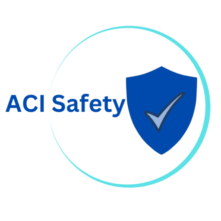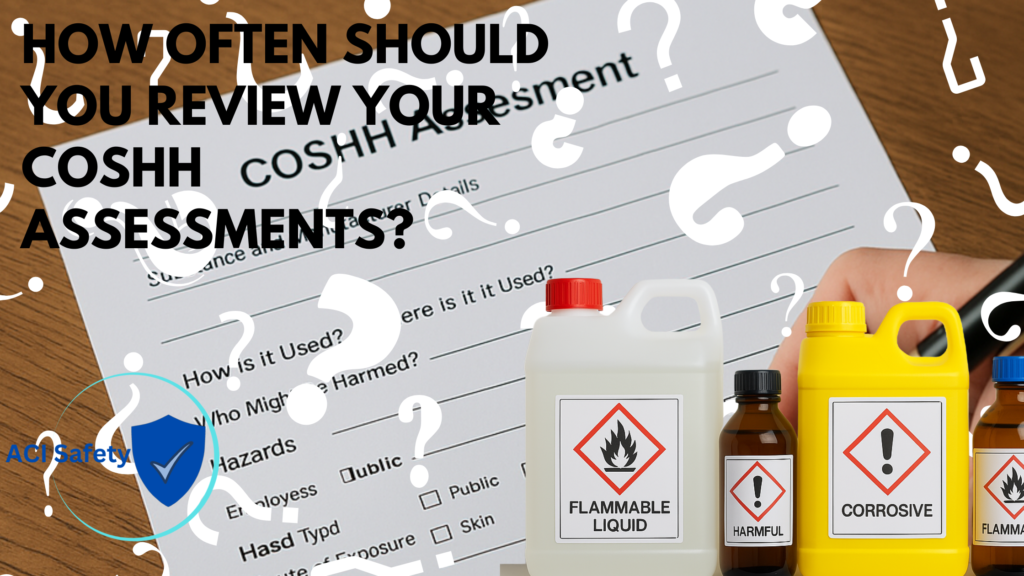You’ve filled out your COSHH assessments, got them filed away (nicely, I hope), and made sure your team knows what’s what. Job done?
Not quite.
COSHH assessments aren’t a once-and-done thing. They need to be reviewed regularly to make sure they still reflect what’s actually happening in your business. That includes checking that your control measures are still working, your substances are still the same, and no one’s started doing something completely different without telling you.
If you’re not sure how often you should be reviewing things—or what sort of changes should trigger a new assessment—this post is for you.
The rule of thumb: review annually (or sooner if something changes)
The general advice is to review your COSHH assessments at least once a year.
That doesn’t mean rewriting the whole thing every 12 months. It just means checking that everything’s still accurate:
- The substance is still in use
- The way it’s used hasn’t changed
- The controls are still in place and effective
- No new information has come to light about the hazards
If everything still stacks up, you can just date it, sign it, and move on. If something has changed, it’s time for an update.
When should you definitely review a COSHH assessment?
There are a few clear situations where a review isn’t optional. If any of these apply, take another look straight away.
1. You introduce a new substance
Even if it looks similar to something you already use, don’t assume it carries the same risks. Every new substance needs its own COSHH assessment, even if it’s just a “more powerful version” of the old one.
2. You change the way a substance is used
Let’s say you’ve gone from applying a paint with a brush to spraying it through an airgun. Totally different risk profile. Even changing how often something is used can make a difference.
3. You move to a new location or change the work environment
Ventilation, lighting, storage… all of these affect how safe a substance is to use. Something that’s fine in a large, open workshop might be risky in a small enclosed space.
4. Someone has an incident or near miss
If someone gets splashed, exposed, or there’s a chemical spill—even if no one’s hurt—it’s a sign that your current controls might not be doing the job.
5. The Safety Data Sheet (SDS) gets updated
Manufacturers sometimes change the formulation or update the SDS with new hazard info. Keep an eye out for these. If you’re ordering supplies and the SDS looks different, check your COSHH assessment still reflects what’s in it.
6. There are changes in legislation or guidance
If the COSHH Regulations change, or HSE releases updated advice, you might need to tweak your assessments to stay compliant.
Why reviewing COSHH assessments matters
Even small businesses have a legal duty to make sure their COSHH assessments are up to date. The law doesn’t say exactly how often you need to review them—but it does say you need to keep them “current and relevant.”
And more importantly, outdated assessments can leave your team exposed to risks you thought were under control.
If you’re ever inspected by the HSE, they’ll want to see that you’re actively managing chemical hazards—not just ticking a box and forgetting about it. An assessment dated three years ago, written for a product you don’t even use anymore? Not a great look.
How to make reviewing easier
If you’re using my COSHH Assessment Template, you’ll see there’s a box for “Review Date” right at the bottom. Fill it in when you first complete the form—usually 12 months from the assessment date.
Then, when that date rolls around, take 10 minutes to go over it. If everything’s still relevant, just update the review date and you’re good to go. If not, make the changes there and then.
This keeps you legally covered and, more importantly, keeps your team safer.
Not sure what to include in your COSHH assessments?
If you’re still working out what to put in each section of the form—or you want to double-check you’re not missing anything—have a read through this post I wrote about what a COSHH assessment should include.
It breaks down everything you need to cover: substance name, hazards, exposure, PPE, storage, emergency measures… all the key bits that make up a solid, practical assessment.
And if you’re totally new to all this, I’ve also written a simple guide to COSHH for small business owners and another one on what COSHH actually means and covers. Those are both good starting points if the whole thing still feels a bit murky.
Need a hand reviewing your existing COSHH assessments?
I work with small businesses all over the UK, offering remote consultancy and guidance for exactly this kind of thing. If you want someone to review your current assessments, help you put a better system in place, or walk through how to do it yourself, just get in touch.
And if you haven’t downloaded it yet, my blank COSHH assessment template makes life a lot easier. It’s written with small businesses in mind, and it’ll guide you through exactly what to include—without turning it into a paperwork marathon.
Because you’ve got better things to do than wrestle with risk assessments all day. Let’s keep it simple and safe.

